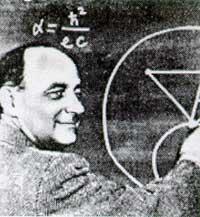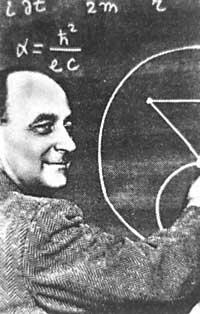Linear and non-linear dispersion waves
1998/09/01 Vega, Luis Iturria: Elhuyar aldizkaria
Observations made by Scottish engineer John Scott Russell in a canal near Edinburgh (1835) are considered the first written description of the solitary wave. In this case, it was a wave originating in low-depth channels that apparently kept the shape and speed unchanged, but that was spreading at high speed for a very long period of time. Russell was able to repeat the event in the laboratory and observed that the speed, height and width of the wave were related: higher speed at higher height but less width.
They had to spend 60 years to find the right mathematical model. After the basic contributions of Stokes (1847), Boususte (1872) and Rayleig (1876), Korteweg and Vries (1895) proposed the equation that bears his name:
(1) ht + (c0 + c1h) hx + nhxxx = 0.
The function h(x,t) measures the deviation of the fluid height at point x and time t of the equilibrium state. The physical constants of the problem are c0, c1 and n. It is easy to see that functions (2) are the solutions of the equation (1), regardless of a>0, checking Russell's observations. The existence of the aforementioned solitary wave is the influence of a certain balance between the dispersion that produces the term that leads to the third derivative and the shock or concentration produced by the non-linear interaction.
In the second half of this century, Kruskal and Zabusky (1965) achieved the KdV equation (which is called this way (equation (1))) as a continuous limit of a one-dimensional network formed by N docks with weak non-linear interaction, according to the model proposed by Fermi, Pasta and Ulam (1955). KdV is exactly the result of a quadratic interaction. When the hhx theme is cubic it is replaced by h2hx. The new equation is called modified KdV (mKdV). Taking the initial simple data (h(x,0) = a cos (2{))), numerical assays were performed and, after a time interval, they saw a train of waves formed by several "solitary waves", with amplitudes and, therefore, different speeds. Being the conditions of the periodic environment, these waves face each other and, yes, surprisingly, they follow the path after the crashes, since it hardly happened. That is, as a linear interaction.
They invented the word "solitoi" for this new type of resolution. In addition, Fermi, Pasta and Ulam also saw what they highlighted as an almost journalistic phenomenon. The transformation that Miura found in its evolution has been decisive, relating the solutions of KdV and mKdV (more specifically, you can see that the amounts that evolution maintains without modifying are infinite). On the other hand, both KdV and mKdV are currently considered "canonical" equations, appearing as an approximation to certain physical models and not only in the dynamics of waves in low-depth channels. You can see the book [1] of the bibliography for these topics and as a reference of previous results.
However, we should not forget that equations are only mathematical models and are a gross simplification of the original physical problem. It is not clear, therefore, if with this procedure we have not lost the essential information. Neither is it guaranteed beforehand that this mathematical model has a solution for a reasonable set of initial data. Also, in case of resolution, that this is unique and ensures correct behavior before small measurement errors of the initial data. We have worked in this field. R. R. Kenig (University of Chicago) and G. With professors Ponce (University of California, Santa Bárbara) and several papers started in 1989 we have developed techniques to address these issues.
Both KdV and mKdV should be considered "small" perturbations of the linear problem to which they are linked. However, it is not clear how this small light should be measured. That is, the instruments of measure and decision of the small and large must be found in the equation of the corresponding partial derivatives. Or, what is the same, look for the relevant parameter of the problem.
According to our research the key can be: Disturbance of the initial profile of the solitary wave that provides the formula (2) with a very oscillating factor (cosNx, N>1) and a sufficiently small amplitude A(N). Then the initial data
(3) h = A(N) cos (Nx) sech2 (x-t/3),
will be for the KdV equation and something similar (placing sech at sech2 place) for mKdV, taking the appropriate particular values of the constants to facilitate their representation. We have seen it in [3] and for mKdV
(4) A(N)< N1/4
In his case, that the resolutions are uniformly aligned. For the KdV equation the result was worse. But this is the J of the Institute for Advanced Study at Princeton. It was directed by Professor Bourgain, demonstrating that A(N)<1 for KdV was sufficient. He invented new techniques for this, which have been very useful in other partial derivatives equations. In particular, Fermi, Pasta and Ulam demonstrated precisely the periodicity observed by numerical methods.
Surprisingly, the result of Bourgain can be improved. In [4] we have shown that amplitude can also grow. In particular, enough is enough
(5) A(N) < N-p , p > 3/4
This result is more in accordance with the condition (4) known for mKdV, since the difference between both is of a unit, as suggested by the transformation of Miura.
Recently we have shown (4) that it is optimal (it is very possible that it is so (5). In particular, using the formula parameter a (2), new solutions with properties of interest have been obtained. On the one hand, except for a residual mass with dispersed behavior, they are waves that move in the opposite direction to the solitary wave that appears in (1). On the other hand, when acting with parameters N and a, replacing the exponent 1/4 in the condition (4) with a smaller one, the uniformity of continuous dependence is lost and, therefore, the instability is demonstrated.
These new solutions are the generalization of others known for Schrödinger's semi-linear equation. Equation
(6) iut = uxx + l u
That is, also canonical and has a close relationship with mKdV, although in our view it is not yet understood well. For example, solitary waves whose profile of hyperbolic secant is the solution of both equations. In addition, the equation (6) contains solitons and the conservation law has an infinite number. And it has a separate property, the immutability with the transformations of Galileo. By means of the present, the resolution corresponding to the data eiNx u0 can be written according to the data u0. Therefore, for (6) it follows the same instability that we have shown for mKdV.
The meaning of this instability from a physical point of view is an inherent question, since (6) it appears as an approximation to physical models of various fields, such as non-linear optics and fluid mechanics. More specifically, and through the transformation of Hasimoto, it is linked to the evolution of a "vortex filament" and, in ferromagnetism, it is the continuous limit of the Heisenberg chain. This solitary wave has its last link to the classic problem of Bernoulli's "elastic curve": Polar writing the complex number that gives the resolution u of the equation (6), the module gives curvature and the argument is the original function of the torsion.
Finally, the instability of these new resolutions can serve to solve another problem. Let us return to the KdV equation and take the constant physics n which measures the dispersion. As indicated above, when the value of this parameter is zero, the model can generate shock waves (just take non-decreasing initial data). The way to continue the resolution after collisions is not the only one. Therefore, we must return to the physical model and use entropy to select a physically significant resolution. Another way to respond to the problem of non-solitude is by solving the equation (2) for values of n, taking the limit. The relationship between the "entropic" solution and the "null dispersion" is not well clarified. We also want to warn that, acting with the parameters N and the new resolutions mentioned above, we can modify the dispersion n.
- Title of the project: Linear and non-linear dispersion waves.
- The objective of the project is the Cauchy problem of dispersion equations, the regularity of the data and initial resolutions, the instability of solutions.
- Director: Luis Vega González
- Working Team: Susana Gutierrez de Gracia yM. Cruz Vilela Bendaña (UPV/EHU); Campaneros: Carlos E. Kenig (University of Chicago) and Gustavo Ponce (University of California, Santa Bárbara)
- Department: Mathematics Mathematics
- Faculty: Faculty: Faculty of Sciences
REFERENCES REFERENCES
- A.C. Newell, Solitons in Mathematics and Physics (SIAM, eds. ), 1985.
- J. Bourgain, Fourier restriction phenomena for certain latticesubsets and applications to nonlinear evolution equations,Geometric and Functional Anal. 3 (1993), 107-156, 209-262.
- C.E. Kening, G. Ponce and L. Vega, Well-posedness and scattering results for the generalized Korteweg-de Vries equation via theccontraction principle, Comm. Pure Apple. Math. 46 (1993), 527-620.
- C.E. Kening, G. Ponce and L. Vega, A bilinear estimate withapplications to the KdV equation, Journal Amer. Math. Soc. 9(1996), 573-603.

Gai honi buruzko eduki gehiago
Elhuyarrek garatutako teknologia






